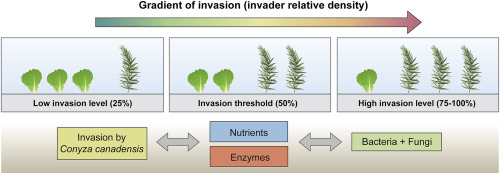Soil Biology and Biochemistry ( IF 9.7 ) Pub Date : 2020-02-03 , DOI: 10.1016/j.soilbio.2020.107739 Hai-Yan Zhang , Priscila Goncalves , Elizabeth Copeland , Shan-Shan Qi , Zhi-Cong Dai , Guan-Lin Li , Cong-Yan Wang , Dao-Lin Du , Torsten Thomas

|
Modifications in soil fertility and microbiota structure driven by invasive plants can initiate a self-promoting mechanism that facilitates their invasion process. This study aimed to resolve how the progression of invasion affects the chemical, biochemical and microbial properties of soil using Conyza canadensis, a widespread and noxious invasive farmland weed, as a model. Different stages of the invasion process were simulated by growing C. canadensis and a non-invasive crop, Lactuca sativa, at different relative densities. Increasing invasion levels (i.e. increasing invader relative densities) resulted in altered properties of the soil, with an overall increase in nutrient supply and enzymatic activities as invasion intensified. Threshold changes in available nitrogen, organic matter and catalase activity in the soil were identified at invasion levels of 69%, 50% and 47%, respectively. Increasing invasion levels also affected the structure of the soil microbiota, with substantial changes occurring in the relative abundance for a number of bacterial and fungal taxa, including some that are relevant to nutrient cycling. Such changes in soil abiotic and biotic composition driven by C. canadensis might lead to positive plant-soil feedbacks that could promote the establishment and spread of the invasive weed.
中文翻译:

杂草Conyza canadensis的入侵改变了土壤养分的供应并改变了微生物群的结构
入侵植物驱动的土壤肥力和微生物群结构的改变可以启动自我促进机制,从而促进其入侵过程。这项研究旨在使用Conyza canadensis(一种广泛而有害的入侵农田杂草)作为模型,解决入侵进程如何影响土壤的化学,生物化学和微生物特性的问题。入侵过程的不同阶段通过生长加拿大念珠菌和非入侵作物紫花苜蓿来模拟,具有不同的相对密度。入侵水平的提高(即入侵者相对密度的提高)导致土壤性质的改变,随着入侵的加剧,养分供应和酶活性的总体增加。入侵土壤中有效氮,有机质和过氧化氢酶活性的阈值变化分别确定为69%,50%和47%。入侵水平的提高也影响了土壤微生物区系的结构,许多细菌和真菌类群的相对丰度发生了重大变化,包括与养分循环有关的一些分类。加拿大念珠菌驱动的土壤非生物和生物成分的这种变化 可能会带来积极的植物土壤反馈,从而促进入侵杂草的建立和传播。



























 京公网安备 11010802027423号
京公网安备 11010802027423号